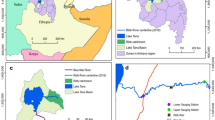Abstract
Pakistan is facing acute power dearth these days due to which people are suffering from privation and their economic condition is deflating. Expensive imported fossil fuel for thermal power generation is pressing them hard and exacerbating the situation. The total power produced in the country by all means is less by 4000 MW than the requirement of Pakistan. So this is the prime time to think about exploring aboriginal and renewable power resources. This article converses about hydro power resources of Swat, North Pakistan, one of the most promising areas in hydro power production. The area drained by the Swat River and its tributary net work is a part of Kohistan Himalayas and has a potential of more than 1000 MW that can contribute 25% to the total energy shortfall in the country and the same is 150% more than the shortfall experienced in the province of Khyber Pakhtunkhwa that hosts Swat Valley. Due to great relief difference acquired within a small stretch, the perennial Swat River and its tributaries become pertinent for power production as high head projects and also gain importance in irrigation as well.
Similar content being viewed by others
References
Alghalith, M., Energy price uncertainty and the manufacturing sector, Energy, 2010, vol. 35, no. 12, pp. 5354–5356.
Bartle, A., Hydropower potential and development activities, Energy Policy, 2002, vol. 30, no. 14, pp. 1231–1239.
Bhutto, A.W. and Karim, S., Energy poverty alleviation in Pakistan through use of indigenous energy resources, Energy Sustainable Dev., 2007, vol. 11, no. 1, pp. 58–67.
Chaudhry, M.N. and Ghazanfar, M.A., Review of the geology of northwest Himalaya, J. Nepal Geol. Soc., Special Issue, 1995, vol. 12, pp. 7–9.
Diesendorf, M., Comparison of employment potential of the coal and wind power industries, Int. J. Environment, Workplace Employment, 2004, vol. 1, no. 1, pp. 82–90.
Dudhani, S., Sinha, A.K., and Inamdar, S.S., Renewable energy sources for peak load demand management in India, Int. J. Electrical Power Energy System, 2006, vol. 28, no. 6, pp. 396–400.
Gul, H. and Chhote Pan Bijli Ghar, Area Study Center, Univ. of Peshawar, 1994 (in Urdu).
Kühn, R., Electric buses-an energy efficient urban transportation means, Energy, 2010, vol. 35, no. 12, pp. 4510–4513.
Kumar, A., Kumar, K., Kaushik, N., et al., Renewable energy in India: current status and future potentials, Renewable Sustainable Energy Rev., 2010, vol. 14, no. 8, pp. 2434–2442.
Lehner, B., Czisch, G., and Vassolo, S., The impact of global change on the hydropower potential of Europe: a model-based analysis, Energy Policy, 2008, vol. 33, no. 7, pp. 839–855.
Liming, H., Financing rural renewable energy. a comparison between China and India, Renewable Sustainable Energy Rev., 2009, vol. 13, no. 5, pp. 1096–1103.
Mirza, U.K., Ahmad, N., Majeed, T., and Harijan, K., Hydropower use in Pakistan: past, present and future, Renewable Sustainable Energy Rev., 2008, vol. 12, no. 6, pp. 1641–1651.
Nouni, M.R., Mullick, S.C., and Kandpal, T.C., Techno-economics of micro-hydro projects for decentralized power supply in India, Energy Policy, 2006, vol. 34, no. 10, pp. 1161–1174.
Paish, O., Small hydro power: technology and current status, Renewable Sustainable Energy Rev., 2002, vol. 6, no. 6, pp. 537–556.
Purohit, P., Small hydro power projects under clean development mechanism in India. A preliminary assessment, Energy Policy, 2008, vol. 36, no. 6, pp. 2000–2015.
Reddy, V.R., Uitto, J.I., Frans, D.R., and Maten, N., Achieving global environmental benefits through local development of clean energy? The case of small hilly hydel in India, Energy Policy, 2006, vol. 34, no. 18, pp. 4069–4080.
Rehman, S.S., Sabir, M.A., and Khan, J., Discharge characteristics and suspended load from rivers of Northern Indus Basin, Pakistan, Geol. Bull. (Univ. Peshawar), 1997, vol. 30, pp. 325–336.
Sabir, M.A., Rehman, S.S., Umar, M., et al., The impact of suspended sediment load on reservoir siltation and energy production: a case study of Indus river and its tributaries, Pol. J. Environ. Stud., 2013, vol. 22, no. 1, pp. 219–225.
Sahir, M.H., and Qureshi, A.H., Assessment of new and renewable energy resources potential and identification of barriers to their significant utilization in Pakistan, Renewable Sustainable Energy Rev., 2008, vol. 12, no. 1, pp. 290–298.
Sheikh, M.A., Energy and renewable energy scenario of Pakistan, Renewable Sustainable Energy Rev., 2010, vol. 14, no. 1, pp. 354–363.
Sung, C.Y., Jin, H.L., and Myung, P.S., Site location analysis for small hydropower using geo-spatial information system, Renewable Energy, 2010, vol. 35, no. 4, pp. 852–861.
Wu, M.-H. and Ni, Y.-S., The effects of oil prices on inflation, interest rates and money, Energy, 2011, vol. 36, no. 7, pp. 4158–4164.
Author information
Authors and Affiliations
Corresponding author
Additional information
The article is published in the original.
Rights and permissions
About this article
Cite this article
Sabir, M.A., Rehman, S.S., Umar, M. et al. Assessment of hydro power potential of Swat, Kohistan Himalayas: A solution for energy shortfall in region. Water Resour 41, 612–618 (2014). https://doi.org/10.1134/S0097807814050091
Received:
Published:
Issue Date:
DOI: https://doi.org/10.1134/S0097807814050091




